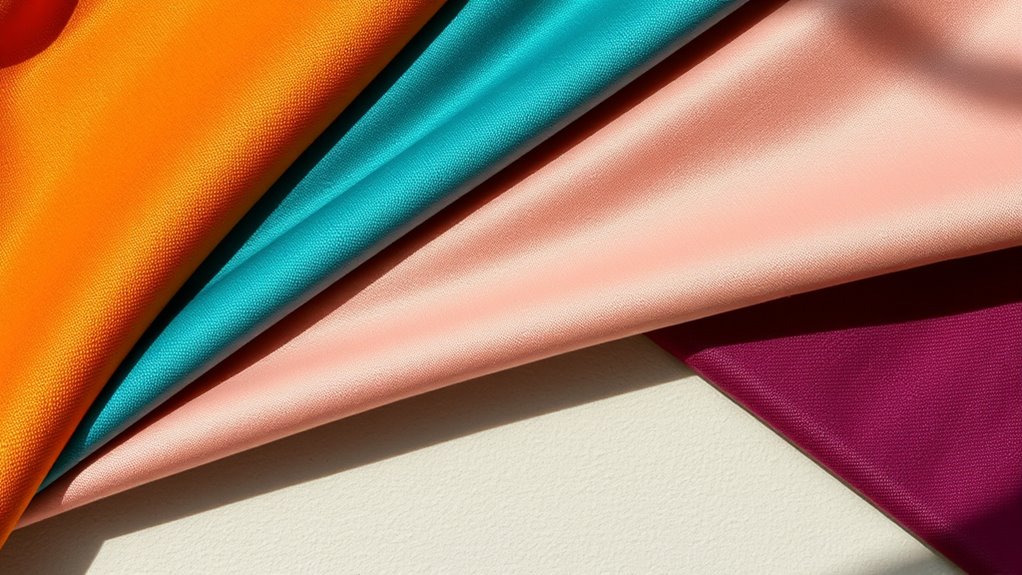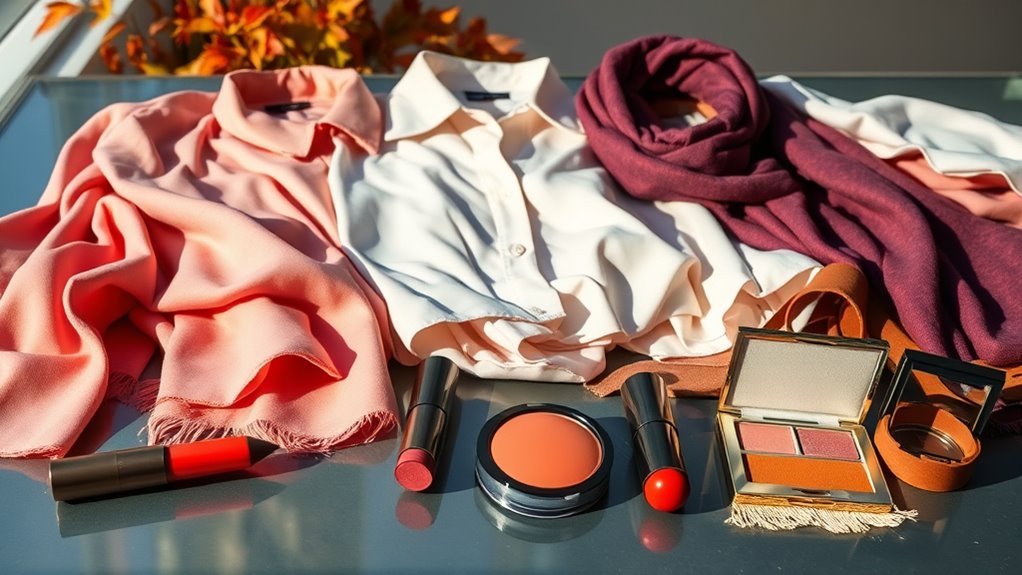Color analysis helps you discover your ideal seasonal palette by examining your skin tone, eye color, and hair color. It groups you into one of four seasons—Winter, Spring, Summer, or Autumn—each with its own flattering shades. Knowing your palette makes choosing clothes and makeup easier, boosting your confidence and enhancing your natural beauty. Keep exploring to learn how to identify your season and use this system to create a harmonious wardrobe.
Key Takeaways
- Color analysis identifies shades that complement your skin, hair, and eye tones, helping you find your most flattering seasonal palette.
- The four seasonal types—Winter, Spring, Summer, Autumn—each have distinct color palettes based on undertones and personal features.
- Self-assessment tools like examining veins, skin reaction to sun, and eye color help determine your seasonal category accurately.
- Incorporating your palette into wardrobe and makeup choices simplifies styling, enhances natural features, and creates cohesive looks.
- Knowing your true seasonal colors boosts confidence, makes dressing easier, and ensures your wardrobe reflects your natural beauty.
Understanding the Basics of Color Analysis

Color analysis is a process that helps you determine which shades complement your natural complexion, hair, and eye color. It’s all about understanding color harmony, ensuring your clothing choices enhance your overall look. When you know your ideal palette, wardrobe coordination becomes effortless, making dressing up more enjoyable and less confusing. This process involves examining your unique coloring to identify the most flattering hues, which can boost your confidence and style consistency. Instead of guessing what suits you, color analysis guides you to select colors that naturally harmonize with your features. By mastering these basics, you’ll create a wardrobe filled with versatile pieces that highlight your best qualities and make mixing and matching simpler. Ultimately, it’s about making smarter, more intentional style choices. Recognizing your seasonal palette can also help you select makeup and accessories that enhance your natural beauty.
The Four Main Seasonal Types: Winter, Spring, Summer, and Autumn

Each seasonal type has a distinct color palette that enhances your natural features. You’ll notice specific seasonal features and tones that make certain colors look more vibrant on you. Understanding these characteristics helps you choose shades that truly complement your overall look. Additionally, being aware of AI security vulnerabilities can help you better interpret and trust technological insights related to personal style analysis.
Characteristic Color Palettes
Understanding the characteristic color palettes of the four main seasonal types helps you identify which hues enhance your natural features. Each season has distinct colors that create ideal color harmony, making it easier to select clothing that complements you. Winter palettes feature cool, deep, and bold shades like blacks, whites, and jewel tones, perfect for striking wardrobe coordination. Spring colors are warm, bright, and lively, including coral, peach, and turquoise, which bring out a fresh glow. Summer palettes consist of soft, muted, and cool shades such as pastels and dusty blues, promoting a gentle, harmonious look. Autumn hues are warm, earthy, and rich—think olive, rust, and deep gold—that emphasize warmth and depth. Recognizing these palettes simplifies choosing colors that naturally enhance your appearance. Both seasonal color analysis and personal coloring play a role in identifying the most flattering hues for each individual.
Seasonal Features and Tones
Knowing your seasonal type reveals key features and tones that naturally enhance your appearance. Each season has distinct seasonal features, such as cool or warm undertones, and specific tone harmony that complements your natural coloring. For example, Winter features high contrast, cool undertones, and icy or jewel-toned hues, creating a striking look. Spring has warm, clear features with golden undertones and soft, bright tones that bring warmth and freshness. Summer’s features are cool, muted, and soft, with pastel and dusty colors that promote harmony. Autumn features warm, rich tones with earthy undertones, emphasizing warmth and depth. Recognizing these seasonal features helps you select colors that harmonize with your natural tone, making your overall appearance more balanced and vibrant. Understanding color harmony is essential for choosing the most flattering palette for your unique features.
How Skin Tone Influences Your Color Palette

Your skin tone plays a crucial role in determining which colors will make you look your best. Your skin’s undertone—whether cool, warm, or neutral—guides you toward shades that enhance your natural glow. Facial pigmentation, such as freckling or uneven tone, can also influence your ideal palette. For example, cool undertones often suit jewel tones like sapphire or emerald, while warm undertones look great in earthy hues like caramel or olive. Recognizing your skin’s undertone helps you avoid colors that wash you out or clash with your complexion. By understanding these subtle cues, you can select a color palette that harmonizes with your skin, creating a balanced and radiant appearance. Monitoring skin tone variations can further refine your color choices and ensure a truly personalized palette. This awareness is the foundation of finding your true seasonal palette.
Eye Color and Its Role in Determining Your Season

Eye color offers a valuable clue in pinpointing your seasonal palette. Your eye color influence and its variation can reveal whether you’re a Winter, Summer, Autumn, or Spring. Here’s how to interpret it:
Eye color helps identify your seasonal palette—cool tones for Winter, muted for Summer, warm for Autumn, and vibrant for Spring.
- Deep, dark eyes like brown or black often suggest a Winter palette with cool undertones.
- Light, soft eyes such as blue or gray may point to a Summer season, emphasizing muted tones.
- Golden or hazel eyes indicate warmth, aligning with Autumn’s rich, earthy colors.
- Bright, clear eyes like emerald green or amber can signal Spring, favoring fresh, vibrant hues.
Understanding the role of eye color in color analysis helps refine your seasonal identification and enhances your wardrobe choices.
The Importance of Hair Color in Color Analysis

Hair color plays a crucial role in color analysis because it directly influences which seasonal palette complements your natural features. Whether you’ve recently used hair dye or added hair highlights, these changes can shift your overall tone. Your hair’s hue affects whether warm or cool shades suit you best. For example, warm blondes often align with spring palettes, while cool brunettes match winter seasons. To illustrate, consider this table:
| Hair Color Type | Ideal Seasonal Palette |
|---|---|
| Warm Hair Dye | Spring or Autumn |
| Cool Hair Highlights | Winter or Summer |
| Natural Warm Tones | Spring or Autumn |
| Cool Natural Tones | Winter or Summer |
Recognizing your hair color helps refine your palette choice, making your wardrobe more harmonious. Additionally, understanding hair color influence can further assist in selecting the most flattering colors for your complexion.
Identifying Your Personal Color Characteristics

Understanding your personal color characteristics is the next step in mastering color analysis. Recognizing your unique features helps you achieve best color harmony and enhance your personal branding. To identify these traits, consider:
- Undertone: Determine if your skin leans warm, cool, or neutral to find colors that complement your natural hue.
- Eye Color: Observe whether your eyes are vibrant or muted, which influences your ideal palette.
- Hair Color: Note the depth and tone of your hair, guiding you toward harmonious shades.
- Contrast Level: Assess how much contrast exists between your features to refine your seasonal palette.
- Additionally, understanding the security of your data can help ensure your personal information remains protected as you explore new style trends.
Tips for Conducting a Self-Assessment at Home

Start by gathering simple tools like a mirror, neutral clothing, and natural light to make your assessment easier. Next, focus on identifying your undertone by checking if your veins appear blue or green and observing how your skin reacts to different colors. This quick step will help you determine which shades complement you best. Additionally, analyzing your natural eye and hair colors can provide further insight into your seasonal palette color analysis methods.
Gather Your Tools
Have you gathered the essential tools before beginning your self-assessment? You’ll need a few key items to make the process smoother. First, get a color wheel to understand color relationships and harmony. Second, gather color swatches or fabric samples that match your clothing or accessories. Third, use a mirror with good lighting to see your skin tone clearly. Fourth, keep a notebook or digital device handy to record your observations. These tools help you compare colors accurately and identify which shades make your complexion glow. Having a variety of color swatches allows you to test different hues easily. With these essentials, you’ll be well-prepared to determine your seasonal palette confidently and find colors that truly suit you.
Identify Your Undertone
To identify your undertone at home, begin by examining your skin in natural light, as artificial lighting can distort true colors. For accurate undertone analysis, look closely at your skin hue—whether it appears more pink, yellow, or neutral. Check the veins on your wrist; if they look blue or purple, you likely have cool undertones. If they seem greenish, your undertone is warm. If you can’t tell, your undertone might be neutral. Consider how your skin reacts to sun exposure: burns easily with pinkish hues or tans deeply with golden tones. Remember, these clues help you determine your undertone, which is essential for finding your perfect seasonal palette. Conduct this self-assessment patiently for the most reliable results, as attention is key to developing a keen eye for subtle color differences.
Common Mistakes to Avoid When Choosing Colors

Choosing the right colors can profoundly impact your overall look, but many people make simple mistakes that hinder their success. First, avoid relying solely on seasonal color myths, which oversimplify complex skin tones and undertones. Second, don’t ignore color psychology; understanding how colors influence mood and perception helps you select flattering shades. Third, steer clear of choosing colors based only on trends rather than what suits your unique palette. Fourth, resist the temptation to pick colors just because they look good on others; your personal coloring is key. By avoiding these mistakes, you ensure your color choices enhance your natural features, boosting confidence and authenticity in your style.
Incorporating Your Seasonal Palette Into Wardrobe and Makeup

Once you’ve identified your seasonal palette and avoided common color mistakes, the next step is integrating these hues into your wardrobe and makeup routines. Achieving color harmony is key to creating a cohesive look. Focus on wardrobe coordination by choosing clothing in shades that complement your natural coloring. For example, if you’re a Winter, incorporate deep jewel tones like emerald or sapphire. Use your palette as a guide for makeup choices, selecting lipstick and blush shades that enhance your overall harmony. To visualize, consider this:
| Wardrobe Items | Makeup Choices |
|---|---|
| Deep reds, blues | Cool-toned lipsticks |
| Soft neutrals | Subtle blushes |
| Brights | Highlighting shades |
This approach guarantees your outfit and makeup work together seamlessly.
Benefits of Knowing Your True Seasonal Colors

Knowing your true seasonal colors allows you to effortlessly select clothing and makeup that enhance your natural features, saving you time and guesswork. When you understand your palette, you can leverage color psychology to boost confidence and mood. Additionally, it simplifies seasonal fashion choices, ensuring your wardrobe remains cohesive and stylish. Benefits include:
- Improved appearance by highlighting your best features with harmonious hues.
- Increased confidence when dressing, knowing your choices flatter you.
- Enhanced understanding of seasonal fashion trends that suit your palette.
- Better decision-making in makeup, accessories, and clothing, saving money and effort. Overall, knowing your true seasonal colors helps you craft a personalized style that feels authentic, vibrant, and effortlessly put together.
Frequently Asked Questions
Can Your Seasonal Palette Change Over Time?
Your seasonal palette can change over time, but typically, there’s a degree of seasonal consistency that maintains your color stability. Factors like aging, skin tone shifts, or lifestyle changes might influence your best colors, making adjustments necessary. While your core palette usually stays the same, slight updates can help you stay harmonious and vibrant. Regularly reassessing guarantees your colors continue to complement your evolving features and uphold color stability.
How Do Artificial Lighting Conditions Affect Color Assessment?
Artificial lighting conditions can substantially impact your color perception, affecting how you see and assess colors. Lighting impact varies with the light’s tone and intensity, which can make colors appear warmer, cooler, or duller than they truly are. When evaluating your seasonal palette, it’s essential to take these effects into account, as poor lighting can lead to inaccurate color choices. Always test colors in natural light for the most true representation.
Are There Alternative Methods to Determine Your Color Season?
You can explore your personal color by experimenting with a color wheel and comparing how different shades make you feel and look. This hands-on approach helps you identify which colors enhance your natural features without relying solely on traditional seasonal palettes. By observing your reactions and the harmony of colors against your skin, you gain a personalized understanding of your true seasonal palette, making your style more authentic and confident.
Can Makeup Shades Alter or Complement Your Seasonal Colors?
Imagine you’re a Spring type, and you want to enhance your natural warmth. Using makeup shades that promote makeup harmony, like peachy blushes or coral lipsticks, can beautifully complement your seasonal colors. These shades boost your overall look and create a seamless color enhancement. Properly chosen makeup can emphasize your best features while maintaining harmony with your palette, making your appearance more vibrant and cohesive.
Is Professional Color Analysis More Accurate Than Self-Assessment?
You might wonder if professional color analysis is more accurate than self-assessment. While personal color theory guides you, seasonal color theory offers a structured approach. A professional can evaluate your skin tone, hair, and eye color objectively, giving you precise results. Self-assessment is helpful, but it can be subjective. So, if accuracy matters, trusting a professional guarantees you find your true seasonal palette, enhancing your style and confidence.
Conclusion
Knowing your true seasonal palette can transform your style—over 80% of people find they look better and feel more confident when wearing colors suited to their season. By understanding your skin tone, eye color, and hair hue, you’ll effortlessly choose shades that enhance your natural beauty. So, take the time to discover your perfect palette; it’s a small step that makes a big difference in how you present yourself every day.









